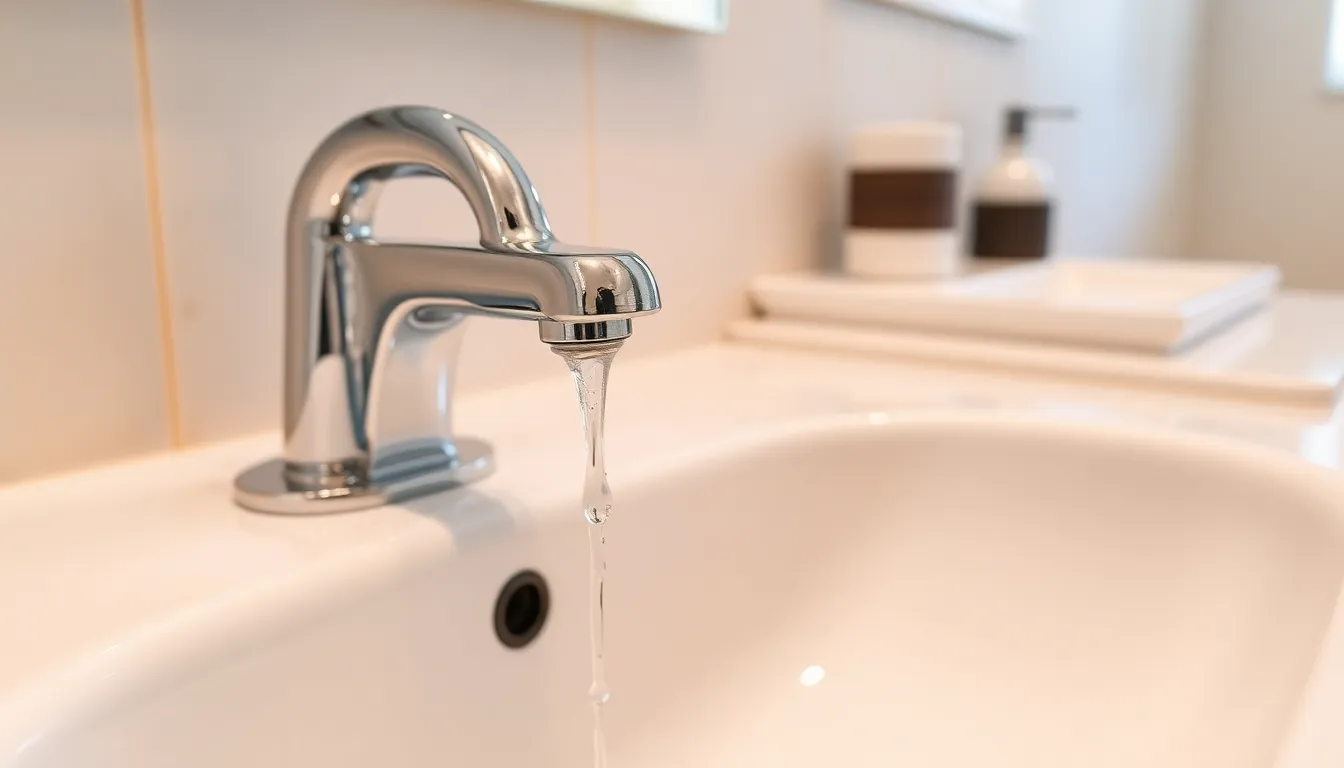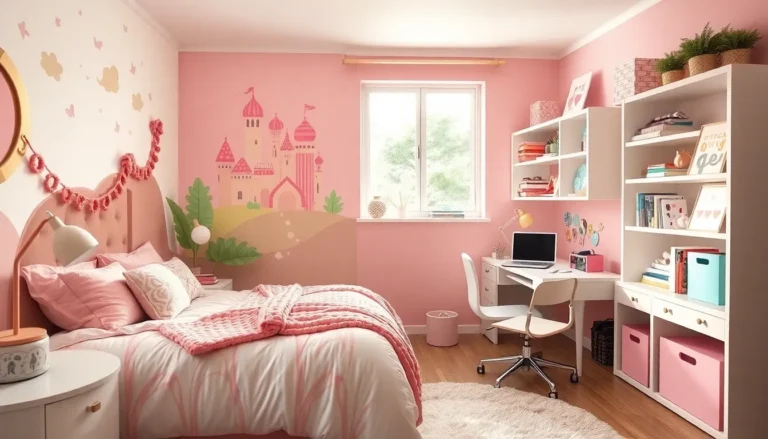When it comes to bathroom plumbing, most folks think it’s all about fixing leaks and unclogging toilets. But let’s be honest—who wouldn’t want a bathroom that feels like a luxurious spa instead of a battle zone? Imagine stepping into a space where everything flows smoothly, and the only thing clogging your mind is how to choose between a bubble bath or a quick shower.
Table of Contents
ToggleOverview of Bathroom Plumbing
Bathroom plumbing encompasses essential components that ensure efficient water flow and waste disposal. Fixtures like sinks, toilets, showers, and bathtubs connect to a network of pipes managing water delivery and drainage. Proper installation and maintenance of these systems enhance a bathroom’s functionality and comfort.
Pipes usually installed include supply pipes, which bring fresh water, and drain pipes, which carry wastewater away. Copper, PVC, and PEX are common materials used for plumbing pipes, each offering specific benefits. For instance, copper pipes resist corrosion, while PEX piping offers flexibility and ease of installation.
Fixtures contribute significantly to bathroom plumbing. Toilets, for example, feature mechanisms like flappers and fill valves that regulate water use. Showers rely on pressure balance valves to maintain consistent water temperatures. Regularly inspecting these fixtures helps identify issues before they become major problems.
Water heaters also play a vital role in bathroom plumbing. Tankless systems provide on-demand hot water, while traditional tanks store heated water for immediate use. Choosing the right type depends on household needs and water consumption patterns.
Drainage systems require attention too. A bathroom should include traps that prevent odors from escaping into the living space. Additionally, vent pipes support airflow, preventing clogs and ensuring proper drainage.
Understanding bathroom plumbing’s components and maintenance needs promotes a stress-free environment. Prioritizing regular inspection and timely repairs ensures a bathroom remains a serene and functional space.
Common Bathroom Plumbing Issues

Bathroom plumbing often faces several common issues that can disrupt a home’s flow and functionality. Identifying and addressing these problems promptly enhances comfort and prevents further damage.
Leaky Faucets
Leaky faucets waste significant amounts of water, impacting utility bills and contributing to environmental concerns. A simple worn-out washer or O-ring may cause these leaks. Replacement generally resolves the issue quickly. Repairing a leaky faucet not only saves water but also prevents damage to surrounding surfaces from prolonged moisture exposure. Regularly inspecting faucets for signs of leaking can catch issues early, ensuring efficient water use.
Clogged Drains
Clogged drains occur frequently due to the buildup of hair, soap, and other debris. These blockages can result in slow drainage or complete backups in sinks, showers, and bathtubs. Utilizing a plunger or a drain snake often clears minor clogs effectively. When DIY methods fail, professional help may be necessary. Preventive measures, such as installing drain covers and avoiding flushing inappropriate items, maintain clear lines and facilitate smooth drainage.
Running Toilets
Running toilets waste water continuously, leading to inflated water bills. A faulty flapper valve or improper float height are common culprits. Adjustments to these components usually restore the toilet’s functionality. Ignoring a running toilet contributes significantly to water waste over time. Regular maintenance also ensures toilets operate correctly, promoting an efficient bathroom environment.
Bathroom Plumbing Components
Bathroom plumbing relies on several essential components for effective operation, ensuring a comfortable and functional environment. Understanding these elements enhances maintenance and efficiency.
Pipes and Fittings
Pipes serve as the backbone of bathroom plumbing, channeling water to fixtures and removing waste. Common materials include PVC for drainage and PEX for water supply, both known for their durability and ease of installation. Fittings connect these pipes, creating a secure framework that prevents leaks. Careful selection of pipe sizes and types ensures proper flow rates and minimizes risks of clogs. Regular inspection of connections can detect potential issues before they escalate.
Fixtures and Appliances
Fixtures such as sinks, toilets, bathtubs, and showers play critical roles in daily bathroom use. Toilets often include dual-flush mechanisms that promote water conservation, while faucets may feature aerators to limit water flow without sacrificing pressure. Water heaters supply hot water for showers and bathing, essential for comfort. Appliances like bidets are increasingly popular, enhancing hygiene and convenience. Selecting efficient fixtures not only improves functionality but also contributes to reducing water bills and environmental impact.
Maintenance Tips for Bathroom Plumbing
Maintaining bathroom plumbing enhances both functionality and comfort. Regular attention to plumbing systems can prevent significant issues.
Regular Inspection
Conducting regular inspections promotes early detection of emerging problems. Checking for leaks in faucets and under sinks helps avoid potential water damage. Monitoring the condition of pipes ensures that any signs of corrosion or wear are addressed quickly. Observing drainage speed reveals clogs before they escalate into severe blockages. Inspecting sealant around tubs and showers prevents water seepage and structural damage. Scheduling these inspections every six months keeps plumbing systems in top shape.
DIY Repair Techniques
Employing DIY repair techniques provides cost-effective solutions. One effective strategy involves replacing worn-out washers in leaky faucets, which can restore functionality without professional help. For clogged drains, using a plunger often clears minor obstructions efficiently. Drain snakes serve as practical tools for tackling more stubborn clogs. Adjusting the float mechanism in a running toilet can resolve continuous water flow issues. Understanding these straightforward techniques empowers homeowners to maintain their bathroom plumbing and mitigate issues swiftly.
When to Call a Professional
Homeowners should call a professional when faced with persistent plumbing problems. Significant water leaks often require expert assistance, especially if they’re hidden behind walls or under floors. In cases where DIY repairs lead to complications like increased leaks or damage, professionals can provide effective solutions.
Complexity in installation also necessitates a plumber’s skills. Installing fixtures or rerouting pipes demands precise knowledge of plumbing systems. Homeowners might encounter overwhelming clogs that resist plunging, indicating a need for professional draining services. Problems such as low water pressure can signal underlying issues that only experienced plumbers can diagnose.
Water heater malfunctions often point to the need for expert intervention. Issues like fluctuating temperatures or strange noises frequently require specialized training for safe repair. If a plumbing problem consistently disrupts daily activities, engaging a licensed plumber proves essential for restoring functionality.
Finally, when considering renovations or upgrades, professionals ensure compliance with local plumbing codes. Proper installation by experts minimizes future headaches, such as leaks or backflow issues. Relying on trained professionals fosters peace of mind and reinforces the integrity of the entire plumbing system in the bathroom.
A well-maintained bathroom plumbing system is key to achieving a relaxing and functional space. By understanding the essential components and addressing common issues promptly homeowners can enhance their bathroom experience. Regular inspections and simple DIY repairs can prevent minor problems from escalating into costly repairs.
When faced with complex issues or significant repairs seeking professional help ensures the plumbing system operates efficiently and safely. Prioritizing both maintenance and expert assistance not only promotes comfort but also contributes to a more sustainable home. Embracing these practices transforms the bathroom into a serene retreat rather than a source of stress.



